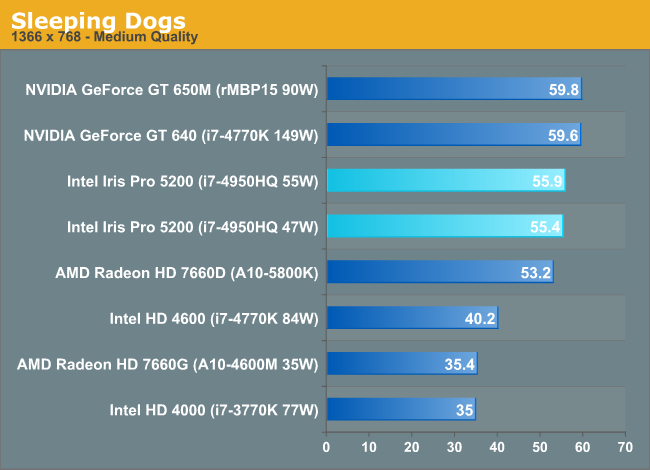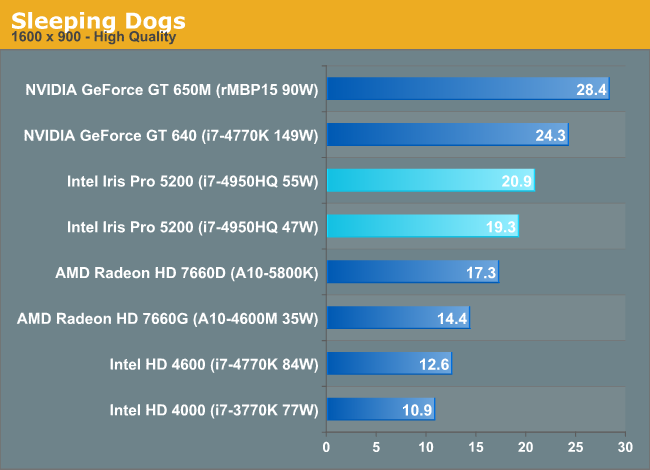Intel Iris Pro 5200 Graphics Review: Core i7-4950HQ Tested
by Anand Lal Shimpi on June 1, 2013 10:01 AM ESTSleeping Dogs
A Square Enix game, Sleeping Dogs is one of the few open world games to be released with any kind of benchmark, giving us a unique opportunity to benchmark an open world game. Like most console ports, Sleeping Dogs’ base assets are not extremely demanding, but it makes up for it with its interesting anti-aliasing implementation, a mix of FXAA and SSAA that at its highest settings does an impeccable job of removing jaggies. However by effectively rendering the game world multiple times over, it can also require a very powerful video card to drive these high AA modes.

At 1366 x 768 with medium quality settings, there doesn't appear to be much of a memory bandwidth limitation here at all. Vsync was disabled but there's a definite clustering of performance close to 60 fps. The gap between the 650M and Iris Pro is just under 7%. Compared to the 77W HD 4000 Iris Pro is good for almost a 60% increase in performance. The same goes for the mobile Trinity comparison.

At higher resolution/higher quality settings, there's a much larger gap between the 650M and Iris Pro 5200. At high quality defaults both FXAA and SSAA are enabled, which given Iris Pro's inferior texture sampling and pixel throughput results in a much larger victory for the 650M. NVIDIA maintains a 30 - 50% performance advantage here. The move from a 47W TDP to 55W gives Iris Pro an 8% performance uplift. If we look at the GT 640's performance relative to the 5200, it's clear that memory bandwidth alone isn't responsible for the performance delta here (although it does play a role).
Once more, compared to all other integrated solutions Iris Pro has no equal. At roughly 2x the performance of a 77W HD 4000, 20% better than a desktop Trinity and 40% better than mobile Trinity, Iris Pro looks very good.










177 Comments
View All Comments
jasonelmore - Sunday, June 2, 2013 - link
Looking at the prices, this will raise the price or Lower the margins of the 13" Retina Macbook Pro by about $150 each.mschira - Sunday, June 2, 2013 - link
Yea laptops benefit most - good for them.But what about the workstation?
So intel stopped being a CPU company and turned into a mediocre GPU company? (can even beat last years GT650M)
I would applaude the rise in GPU performance if they had not completely forgotten the CPU.
M.
n13L5 - Monday, June 3, 2013 - link
You're exactly right.13" ultrabook buyers who need it the most get little to nothing out of this.
And desktop users don't need or want GT3e and it uses system RAM. Better off buying a graphics card instead of upgrading to Haswell on desktops.
glugglug - Tuesday, June 4, 2013 - link
While I agree this misses "where it would benefit most", I disagree on just *where* that is.I guess Intel agrees with Microsofts implicit decision that media center is dead. Real-time HQ quicksync would be perfect to transcode anything extenders couldn't handle, and would also make the scanning for and skipping of commercials incredibly efficient.
n13L5 - Tuesday, June 11, 2013 - link
Core i5…4350U…Iris 5000…15W…1.5 GHzCore i7…4550U…Iris 5000…15W…1.5 GHz
Core i7…4650U…Iris 5000…15W…1.7 GHz
These should work. The 4650U is available in the Sony Duo 13 as we speak, though at a hefty price tag of $1,969
Eric S - Monday, July 1, 2013 - link
The last 13" looks like they were prepping it for a fusion drive then changed their mind leaving extra space in the enclosure. I think it is due for an internal redesign that could allow for a higher wattage processor.I think the big deal is the OpenCL performance paired with ECC memory for the GPU. The Nvidia discrete processor uses non-ECC GDDR. This will be a big deal for users of Adobe products. Among other things, this solves the issue of using the Adobe mercury engine with non-ECC memory and the resulting single byte errors in the output. The errors are not a big deal for games, but may not be ideal for rendering professional output and scientific applications. This is basically a mobile AMD FireGL or Nvidia Quadro card. Now we just need OpenCL support for the currently CUDA-based mercury engines in After Effects and Premiere. I have a feeling that is coming or Adobe will also lose Mercury Engine compatibility with the new Mac Pro.
tviceman - Saturday, June 1, 2013 - link
Impressive iGPU performance, but I knew Intel was absolutely full of sh!t when claiming equal to or better than GT 650m performance. Not really even close, typically behind by 30-50% across the board.Krysto - Saturday, June 1, 2013 - link
When isn't Intel full of shit? Always take what the improvements they claim and cut it in half, and you'll be a lot closer to reality.xtc-604 - Saturday, June 8, 2013 - link
Lol...you think that's bad? Look at Apple's claims. "over 200 new improvements in Mountain Lion"piroroadkill - Saturday, June 1, 2013 - link
sh<exclamation point>t? What are we? 9?